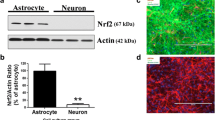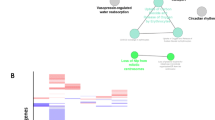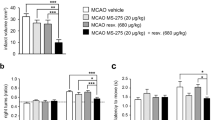Abstract
Neuroprotective agents administered post-cerebral ischemia have failed so far in the clinic to promote significant recovery. Thus, numerous efforts were redirected toward prophylactic approaches such as preconditioning as an alternative therapeutic strategy. Our laboratory has revealed a novel long-term window of cerebral ischemic tolerance mediated by resveratrol preconditioning (RPC) that lasts for 2 weeks in mice. To identify its mediators, we conducted an RNA-seq experiment on the cortex of mice 2 weeks post-RPC, which revealed 136 differentially expressed genes. The majority of genes (116/136) were downregulated upon RPC and clustered into biological processes involved in transcription, synaptic signaling, and neurotransmission. The downregulation in these processes was reminiscent of metabolic depression, an adaptation used by hibernating animals to survive severe ischemic states by downregulating energy-consuming pathways. Thus, to assess metabolism, we used a neuronal-astrocytic co-culture model and measured the cellular respiration rate at the long-term window post-RPC. Remarkably, we observed an increase in glycolysis and mitochondrial respiration efficiency upon RPC. We also observed an increase in the expression of genes involved in pyruvate uptake, TCA cycle, and oxidative phosphorylation, all of which indicated an increased reliance on energy-producing pathways. We then revealed that these nuclear and mitochondrial adaptations, which reduce the reliance on energy-consuming pathways and increase the reliance on energy-producing pathways, are epigenetically coupled through acetyl-CoA metabolism and ultimately increase baseline ATP levels. This increase in ATP would then allow the brain, a highly metabolic organ, to endure prolonged durations of energy deprivation encountered during cerebral ischemia.









Similar content being viewed by others
References
Clarke DD, Sokoloff L (1999) Circulation and energy metabolism of the brain. In: Siegel GJ et al (eds) Basic neurochemistry, 6th edition molecular, cellular and medical aspects. Lippincott-Raven, Philadelphia, pp. 637–669
Benjamin EJ, Blaha MJ, Chiuve SE, Cushman M, Das SR, Deo R, de Ferranti SD, Floyd J et al (2017) Heart Disease and Stroke Statistics—2017 Update: A Report From the American Heart Association. Circulation 135(10):e146–e603
Sims NR, Muyderman H (2010) Mitochondria, oxidative metabolism and cell death in stroke. Biochim Biophys Acta 1802(1):80–91
Kikuchi K, Tanaka E, Murai Y, Tancharoen S (2014) Clinical trials in acute ischemic stroke. CNS Drugs 28(10):929–938
Minnerup J, Sutherland BA, Buchan AM, Kleinschnitz C (2012) Neuroprotection for stroke: current status and future perspectives. Int J Mol Sci 13(9):11753–11772
Lansberg MG, Bluhmki E, Thijs VN (2009) Efficacy and safety of tissue plasminogen activator 3 to 4.5 hours after acute ischemic stroke: a metaanalysis. Stroke 40(7):2438–2441
Khoury N, Koronowski KB, Perez-Pinzon MA (2016) Long-term window of ischemic tolerance: an evolutionarily conserved form of metabolic plasticity regulated by epigenetic modifications? J Neurol Neuromedicine 1(2):6–12
Raval AP, Dave KR, Perez-Pinzon MA (2006) Resveratrol mimics ischemic preconditioning in the brain. J Cereb Blood Flow Metab 26(9):1141–1147
Koronowski KB, Dave KR, Saul I, Camarena V, Thompson JW, Neumann JT, Young JI, Perez-Pinzon MA (2015) Resveratrol preconditioning induces a novel extended window of ischemic tolerance in the mouse brain. Stroke 46(8):2293–2298
Koronowski KB, Khoury N, Saul I, Loris ZB, Cohan CH, Stradecki-Cohan HM, Dave KR, Young JI et al (2017) Neuronal SIRT1 (silent information regulator 2 homologue 1) regulates glycolysis and mediates resveratrol-induced ischemic tolerance. Stroke 48(11):3117–3125
Narayanan SV, Dave KR, Saul I, Perez-Pinzon MA (2015) Resveratrol preconditioning protects against cerebral ischemic injury via nuclear erythroid 2-related factor 2. Stroke 46(6):1626–1632
Morris-Blanco KC, Cohan CH, Neumann JT, Sick TJ, Perez-Pinzon MA (2014) Protein kinase C epsilon regulates mitochondrial pools of Nampt and NAD following resveratrol and ischemic preconditioning in the rat cortex. J Cereb Blood Flow Metab 34(6):1024–1032
Della-Morte D, Dave KR, DeFazio RA, Bao YC, Raval AP, Perez-Pinzon MA (2009) Resveratrol pretreatment protects rat brain from cerebral ischemic damage via a sirtuin 1-uncoupling protein 2 pathway. Neuroscience 159(3):993–1002
Stowe AM, Altay T, Freie AB, Gidday JM (2011) Repetitive hypoxia extends endogenous neurovascular protection for stroke. Ann Neurol 69(6):975–985
Cox-Limpens KE, Gavilanes AW, Zimmermann LJ, Vles JS (2014) Endogenous brain protection: what the cerebral transcriptome teaches us. Brain Res 1564:85–100
Narayanan SV, Dave KR, Perez-Pinzon MA (2013) Ischemic preconditioning and clinical scenarios. Curr Opin Neurol 26(1):1–7
Seshadri S, Beiser A, Kelly-Hayes M, Kase CS, Au R, Kannel WB, Wolf PA (2006) The lifetime risk of stroke: estimates from the Framingham study. Stroke 37(2):345–350
Barger JL, Kayo T, Vann JM, Arias EB, Wang J, Hacker TA, Wang Y, Raederstorff D et al (2008) A low dose of dietary resveratrol partially mimics caloric restriction and retards aging parameters in mice. PLoS One 3(6):e2264
Thomas J, Garg ML, Smith DW (2013) Dietary supplementation with resveratrol and/or docosahexaenoic acid alters hippocampal gene expression in adult C57Bl/6 mice. J Nutr Biochem 24(10):1735–1740
Stenzel-Poore MP, Stevens SL, Xiong Z, Lessov NS, Harrington CA, Mori M, Meller R, Rosenzweig HL et al (2003) Effect of ischaemic preconditioning on genomic response to cerebral ischaemia: similarity to neuroprotective strategies in hibernation and hypoxia-tolerant states. Lancet 362(9389):1028–1037
Stenzel-Poore MP, Stevens SL, Simon RP (2004) Genomics of preconditioning. Stroke 35(11 Suppl 1):2683–2686
Gao D, Huang T, Jiang X, Hu S, Zhang L, Fei Z (2014) Resveratrol protects primary cortical neuron cultures from transient oxygen-glucose deprivation by inhibiting MMP-9. Mol Med Rep 9(6):2197–2204
Huang T, Gao D, Jiang X, Hu S, Zhang L, Fei Z (2014) Resveratrol inhibits oxygen-glucose deprivation-induced MMP-3 expression and cell apoptosis in primary cortical cells via the NF-kappaB pathway. Mol Med Rep 10(2):1065–1071
Tang F, Guo S, Liao H, Yu P, Wang L, Song X, Chen J, Yang Q (2017) Resveratrol enhances neurite outgrowth and synaptogenesis via sonic hedgehog signaling following oxygen-glucose deprivation/reoxygenation injury. Cell Physiol Biochem 43(2):852–869
Herculano-Houzel S, Mota B, Lent R (2006) Cellular scaling rules for rodent brains. Proc Natl Acad Sci U S A 103(32):12138–12143
Kim-Han JS, Dugan LL (2005) Mitochondrial uncoupling proteins in the central nervous system. Antioxid Redox Signal 7(9–10):1173–1181
Caruso F, Mendoza L, Castro P, Cotoras M, Aguirre M, Matsuhiro B, Isaacs M, Rossi M et al (2011) Antifungal activity of resveratrol against Botrytis cinerea is improved using 2-furyl derivatives. PLoS One 6(10):e25421
Gledhill JR, Montgomery MG, Leslie AG, Walker JE (2007) Mechanism of inhibition of bovine F1-ATPase by resveratrol and related polyphenols. Proc Natl Acad Sci U S A 104(34):13632–13637
Zheng J, Ramirez VD (2000) Inhibition of mitochondrial proton F0F1-ATPase/ATP synthase by polyphenolic phytochemicals. Br J Pharmacol 130(5):1115–1123
Dave KR, Christian SL, Perez-Pinzon MA, Drew KL (2012) Neuroprotection: lessons from hibernators. Comp Biochem Physiol B Biochem Mol Biol 162(1–3):1–9
Lutz PL, Nilsson GE, Perez-Pinzon MA (1996) Anoxia tolerant animals from a neurobiological perspective. Comp Biochem Physiol B Biochem Mol Biol 113(1):3–13
Storey KB, Storey JM (2010) Metabolic rate depression: the biochemistry of mammalian hibernation. Adv Clin Chem 52:77–108
Scornavacca G, Gesuete R, Orsini F, Pastorelli R, Fanelli R, de Simoni MG, Airoldi L (2012) Proteomic analysis of mouse brain cortex identifies metabolic down-regulation as a general feature of ischemic pre-conditioning. J Neurochem 122(6):1219–1229
Navarro G, Martinez-Pinilla E, Sanchez-Melgar A, Ortiz R, Noe V, Martin M, Ciudad C, Franco R (2017) A genomics approach identifies selective effects of trans-resveratrol in cerebral cortex neuron and glia gene expression. PLoS One 12(4):e0176067
Stapels M, Piper C, Yang T, Li M, Stowell C, Xiong ZG, Saugstad J, Simon RP et al (2010) Polycomb group proteins as epigenetic mediators of neuroprotection in ischemic tolerance. Sci Signal 3(111):ra15
Neumann JT, Thompson JW, Raval AP, Cohan CH, Koronowski KB, Perez-Pinzon MA (2015) Increased BDNF protein expression after ischemic or PKC epsilon preconditioning promotes electrophysiologic changes that lead to neuroprotection. J Cereb Blood Flow Metab 35(1):121–130
DeFazio RA, Raval AP, Lin HW, Dave KR, Della-Morte D, Perez-Pinzon MA (2009) GABA synapses mediate neuroprotection after ischemic and epsilonPKC preconditioning in rat hippocampal slice cultures. J Cereb Blood Flow Metab 29(2):375–384
Lei M, Dong D, Mu S, Pan YH, Zhang S (2014) Comparison of brain transcriptome of the greater horseshoe bats (Rhinolophus ferrumequinum) in active and torpid episodes. PLoS One 9(9):e107746
Cohan CH, Stradecki-Cohan HM, Morris-Blanco KC, Khoury N, Koronowski KB, Youbi M, Wright CB, Perez-Pinzon MA (2017) Protein kinase C epsilon delays latency until anoxic depolarization through arc expression and GluR2 internalization. J Cereb Blood Flow Metab 37(12):3774–3788
Salin K, Auer SK, Rey B, Selman C, Metcalfe NB (2015) Variation in the link between oxygen consumption and ATP production, and its relevance for animal performance. Proc Biol Sci 282(1812):20151028
Shi L, Tu BP (2015) Acetyl-CoA and the regulation of metabolism: mechanisms and consequences. Curr Opin Cell Biol 33:125–131
Wellen KE, Hatzivassiliou G, Sachdeva UM, Bui TV, Cross JR, Thompson CB (2009) ATP-citrate lyase links cellular metabolism to histone acetylation. Science 324(5930):1076–1080
Zhao S, Torres A, Henry RA, Trefely S, Wallace M, Lee JV, Carrer A, Sengupta A et al (2016) ATP-citrate Lyase controls a glucose-to-acetate metabolic switch. Cell Rep 17(4):1037–1052
Choudhary C, Weinert BT, Nishida Y, Verdin E, Mann M (2014) The growing landscape of lysine acetylation links metabolism and cell signalling. Nat Rev Mol Cell Biol 15(8):536–550
Chung JH, Manganiello V, Dyck JR (2012) Resveratrol as a calorie restriction mimetic: therapeutic implications. Trends Cell Biol 22(10):546–554
Howitz KT, Bitterman KJ, Cohen HY, Lamming DW, Lavu S, Wood JG, Zipkin RE, Chung P et al (2003) Small molecule activators of sirtuins extend Saccharomyces cerevisiae lifespan. Nature 425(6954):191–196
de Oliveira MR, Nabavi SF, Manayi A, Daglia M, Hajheydari Z, Nabavi SM (2016) Resveratrol and the mitochondria: from triggering the intrinsic apoptotic pathway to inducing mitochondrial biogenesis, a mechanistic view. Biochim Biophys Acta 1860(4):727–745
Beher D, Wu J, Cumine S, Kim KW, Lu SC, Atangan L, Wang M (2009) Resveratrol is not a direct activator of SIRT1 enzyme activity. Chem Biol Drug Des 74(6):619–624
Kaeberlein M, McDonagh T, Heltweg B, Hixon J, Westman EA, Caldwell SD, Napper A, Curtis R et al (2005) Substrate-specific activation of sirtuins by resveratrol. J Biol Chem 280(17):17038–17045
Dasgupta B, Milbrandt J (2007) Resveratrol stimulates AMP kinase activity in neurons. Proc Natl Acad Sci U S A 104(17):7217–7222
Canto C, Gerhart-Hines Z, Feige JN, Lagouge M, Noriega L, Milne JC, Elliott PJ, Puigserver P et al (2009) AMPK regulates energy expenditure by modulating NAD+ metabolism and SIRT1 activity. Nature 458(7241):1056–1060
Madrigal-Perez LA, Ramos-Gomez M (2016) Resveratrol inhibition of cellular respiration: new paradigm for an old mechanism. Int J Mol Sci 17(3):368
Tang BL (2010) Resveratrol is neuroprotective because it is not a direct activator of Sirt1-a hypothesis. Brain Res Bull 81(4–5):359–361
Adak T, Samadi A, Ünal AZ, Sabuncuoğlu S (2018) A reappraisal on metformin. Regul Toxicol Pharmacol 92:324–332
Arbelaez-Quintero I, Palacios M (2017) To use or not to use metformin in cerebral ischemia: a review of the application of metformin in stroke rodents. Stroke Res Treat 2017:9756429
Cheng YY, Leu HB, Chen TJ, Chen CL, Kuo CH, Lee SD, Kao CL (2014) Metformin-inclusive therapy reduces the risk of stroke in patients with diabetes: a 4-year follow-up study. J Stroke Cerebrovasc Dis 23(2):e99–e105
(1998) Effect of intensive blood-glucose control with metformin on complications in overweight patients with type 2 diabetes (UKPDS 34). UK prospective diabetes study (UKPDS) group. Lancet 352(9131)854–65
Riepe MW, Esclaire F, Kasischke K, Schreiber S, Nakase H, Kempski O, Ludolph AC, Dirnagl U et al (1997) Increased hypoxic tolerance by chemical inhibition of oxidative phosphorylation: “chemical preconditioning”. J Cereb Blood Flow Metab 17(3):257–264
Busija DW, Gaspar T, Domoki F, Katakam PV, Bari F (2008) Mitochondrial-mediated suppression of ROS production upon exposure of neurons to lethal stress: mitochondrial targeted preconditioning. Adv Drug Deliv Rev 60(13–14):1471–1477
Jain IH, Zazzeron L, Goli R, Alexa K, Schatzman-Bone S, Dhillon H, Goldberger O, Peng J et al (2016) Hypoxia as a therapy for mitochondrial disease. Science 352(6281):54–61
Ferrari M, Jain IH, Goldberger O, Rezoagli E, Thoonen R, Cheng KH, Sosnovik DE, Scherrer-Crosbie M et al (2017) Hypoxia treatment reverses neurodegenerative disease in a mouse model of Leigh syndrome. Proc Natl Acad Sci U S A 114(21):E4241–E4250
Arroyo JD, Jourdain AA, Calvo SE, Ballarano CA, Doench JG, Root DE, Mootha VK (2016) A genome-wide CRISPR death screen identifies genes essential for oxidative phosphorylation. Cell Metab 24(6):875–885
Velmeshev D, Magistri M, Faghihi MA (2013) Expression of non-protein-coding antisense RNAs in genomic regions related to autism spectrum disorders. Mol Autism 4(1):32
Magistri M, Khoury N, Mazza EM, Velmeshev D, Lee JK, Bicciato S, Tsoulfas P, Faghihi MA (2016) A comparative transcriptomic analysis of astrocytes differentiation from human neural progenitor cells. Eur J Neurosci 44(10):2858–2870
Acknowledgments
We would like to acknowledge Claudia Sofia Pereira and Tania Arguello for their help with the Seahorse Biosciences experiments and Isabel Saul for her help with animal blinding and injections.
Funding
This work was supported by the NIH/NINDS grants NS45676, NS054147, NS097658, and NS34773 (to M.A.P.P.), the American Heart Association (AHA) predoctoral award 16PRE29170004 (to N.K.), the NIH F31 predoctoral award NS089356-01A1 (to K.B.K.), and the Lois Pope LIFE Foundation Fellowship (to N.K. and K.B.K.)
Author information
Authors and Affiliations
Corresponding author
Electronic supplementary material
Supplementary Fig. 1
RPC increases protein levels of ARC at the long-term window post RPC in vivo. a Western blot analysis showing protein levels of ARC and ACTB in the cortex of mice 2 weeks post-RPC. b Quantification of the protein levels of ARC relative to ACTB based on the western blot analysis results. (PNG 124 kb)
Supplementary Fig. 2
Publically available datasets involving the transcriptomic analysis of mice brains after resveratrol administration. a In the study by Barger et al. in 2008, 30-month-old mice were fed 5 mg/kg resveratrol for 14 months after which their neocortex was subject to a microarray analysis. After analyzing their results using the GEO (Gene Expression Omnibus) tool (GEO2R), we identified 700 differentially expressed genes among which the majority of genes including 473 (67.6%) were significantly downregulated and only 227 (32.4%) genes were upregulated. b In a similar study by Thomas et al. in 2013, 8-week-old mice were fed a much higher dose of resveratrol consisting of 50 mg/kg per day for 6 weeks after which their hippocampus was subject to a microarray analysis. Among the 439 differentially expressed genes, strikingly 422 (96.1%) genes were downregulated and only a very small subset of 17 (3.9%) genes was upregulated. The results of these experiments further support the global downregulation in gene expression that we observed in the cortex of mice 2 weeks post-RPC. (PNG 492 kb)
Supplementary Fig. 3
Immunofluorescence staining of the neuronal-astrocytic co-cultures at the long-term window post-RPC confirming cellular identity. Representative images showing the neuronal-astrocytic co-culture model stained with DAPI (blue), NeuN (red), MAP2 (magenta), and GFAP (green) at the 6-day time point post-RPC. (DAPI—4′,6-diamidino-2-phenylindole, GFAP—glial fibrillary acidic protein, NeuN—neuronal nuclei, MAP2—microtubule associated protein 2). (PNG 840 kb)
Supplementary Fig. 4
Immunofluorescence staining of the neuronal-astrocytic co-cultures at the long-term window post-RPC confirming neuronal abundance. a Representative images showing the neuronal-astrocytic co-culture model stained with DAPI (blue) and NeuN (magenta) after 6 days from Res or Veh treatment. b Bar graph showing the percentage of neuron relative to DAPI based on the immunostaining results (n = 2; one-way ANOVA; ns, not significant). (PNG 1126 kb)
Supplementary Table 1
The list of genes identified from the RNA-seq analysis 2 weeks post-RPC (XLSX 1856 kb)
Supplementary Table 2
The list of genes identified from the microarray analysis conducted on the neocortex from Barger et al. 2008 (XLSX 2357 kb)
Supplementary Table 3
The list of genes identified from the microarray analysis conducted on the hippocampus from Thomas et al. 2013 (XLSX 19 kb)
Supplementary Table 4
The list and sequence of primers used in the real-time PCR experiments (XLSX 14 kb)
Rights and permissions
About this article
Cite this article
Khoury, N., Xu, J., Stegelmann, S.D. et al. Resveratrol Preconditioning Induces Genomic and Metabolic Adaptations within the Long-Term Window of Cerebral Ischemic Tolerance Leading to Bioenergetic Efficiency. Mol Neurobiol 56, 4549–4565 (2019). https://doi.org/10.1007/s12035-018-1380-6
Received:
Accepted:
Published:
Issue Date:
DOI: https://doi.org/10.1007/s12035-018-1380-6




